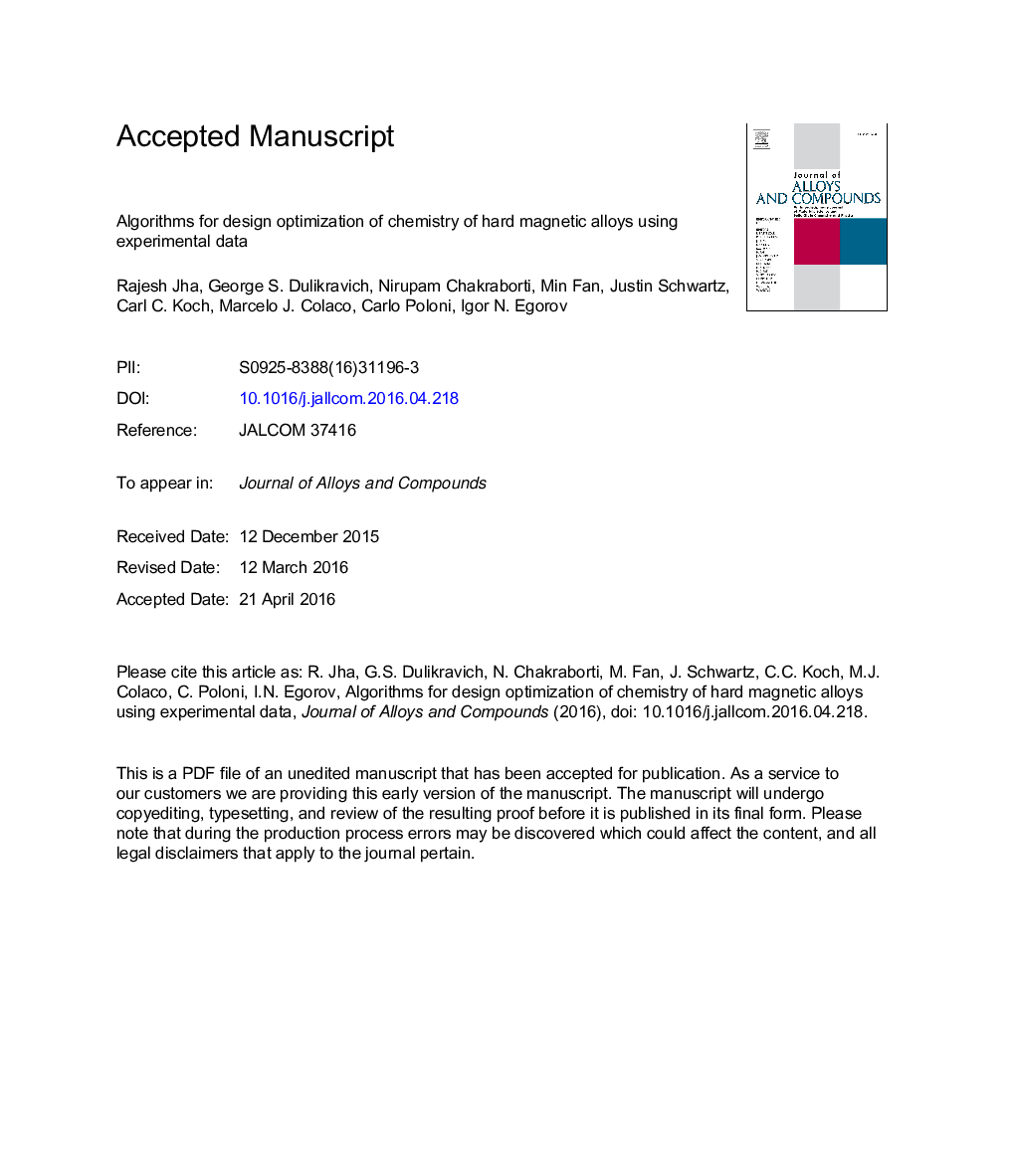| کد مقاله | کد نشریه | سال انتشار | مقاله انگلیسی | نسخه تمام متن |
|---|---|---|---|---|
| 7997089 | 1516211 | 2016 | 46 صفحه PDF | دانلود رایگان |
عنوان انگلیسی مقاله ISI
Algorithms for design optimization of chemistry of hard magnetic alloys using experimental data
ترجمه فارسی عنوان
الگوریتم برای طراحی بهینه سازی شیمی از آلیاژهای مغناطیسی سخت با استفاده از داده های تجربی
دانلود مقاله + سفارش ترجمه
دانلود مقاله ISI انگلیسی
رایگان برای ایرانیان
کلمات کلیدی
طراحی آلیاژها، مواد مغناطیسی، طراحی مواد محاسباتی، سطوح پاسخ، مدل های متا، بهینه سازی چند هدفه، پیش بینی های بهینه شده پاریتو،
ترجمه چکیده
الگوریتم تولید چند بعدی تصادفی برای توزیع غلظت های شیمیایی هر یک از عناصر آلیاژی در آلیاژهای کادمیوم به صورت یکنواخت امکان پذیر بود در حالی که حفظ مقادیر تجویز شده بر روی حداقل و حداکثر مقادیر مجاز برای غلظت هر یک از عناصر آلیاژی استفاده شد. سپس قطعات تولید شده آلیاژی مورد نظر برای تعادل فاز و خواص مغناطیسی مرتبط با استفاده از پایگاه داده ترمودینامیکی در محدوده مورد نظر مورد بررسی قرار گرفت. این آلاینده های اولیه کاندید ساخته شده، سنتز شده و برای خواص مورد نظر آزمایش شده اند. سپس، مقادیر آزمایش شده حاصل از خواص با یک سطح پاسخ چند بعدی مجهز شدند. خواص مورد نظر به عنوان اهداف مورد آزمایش قرار گرفتند و همزمان با استفاده از یک الگوریتم بهینه سازی چند هدفه که بهینه سازی غلظت هر یک از عناصر آلیاژی بود، به طور همزمان شدت یافتند. این وظیفه نیز توسط یک سطح واکنش مفهومی دیگر پاسخ و الگوریتم بهینه سازی برای دوبار بررسی نتایج انجام شد. بعضی از بهترین ترکیبات آلومینیوم بهینه شده پارتو پیش بینی شده، سپس به منظور ارزیابی خواص ماکروسکوپی خویش، تولید، سنتز شده و آزمایش شدند. تعدادی از این آلیاژهای بهینه شده پارتو بیشتر از آلیاژهای کادمیوم در بسیاری از اهداف را به خوبی انجام دادند. این امر اثربخشی روش متا مدلسازی و روش تجربی در طراحی بهینه سازی آلیاژ را اثبات می کند. تجزیه و تحلیل حساسیت هر یک از عناصر آلیاژی نیز برای تعیین اینکه آیا عناصر آلیاژی حداقل به خواص مغناطیسی مورد نظر آلیاژ می انجامد، انجام می شود. سپس این عناصر می توانند با عناصر آلیاژ دیگر کاندیدا مانند عناصر کمیاب زمین غیرقابل جایگزینی جایگزین شوند.
موضوعات مرتبط
مهندسی و علوم پایه
مهندسی مواد
فلزات و آلیاژها
چکیده انگلیسی
A multi-dimensional random number generation algorithm was used to distribute chemical concentrations of each of the alloying elements in the candidate alloys as uniformly as possible while maintaining the prescribed bounds on the minimum and maximum allowable values for the concentration of each of the alloying elements. The generated candidate alloy compositions were then examined for phase equilibria and associated magnetic properties using a thermodynamic database in the desired temperature range. These initial candidate alloys were manufactured, synthesized and tested for desired properties. Then, the experimentally obtained values of the properties were fitted with a multi-dimensional response surface. The desired properties were treated as objectives and were extremized simultaneously by utilizing a multi-objective optimization algorithm that optimized the concentrations of each of the alloying elements. This task was also performed by another conceptually different response surface and optimization algorithm for double-checking the results. A few of the best predicted Pareto optimal alloy compositions were then manufactured, synthesized and tested to evaluate their macroscopic properties. Several of these Pareto optimized alloys outperformed most of the candidate alloys on most of the objectives. This proves the efficacy of the combined meta-modeling and experimental approach in design optimization of the alloys. A sensitivity analysis of each of the alloying elements was also performed to determine which of the alloying elements contributes the least to the desired macroscopic properties of the alloy. These elements can then be replaced with other candidate alloying elements such as not-so-rare earth elements.
ناشر
Database: Elsevier - ScienceDirect (ساینس دایرکت)
Journal: Journal of Alloys and Compounds - Volume 682, 15 October 2016, Pages 454-467
Journal: Journal of Alloys and Compounds - Volume 682, 15 October 2016, Pages 454-467
نویسندگان
Rajesh Jha, George S. Dulikravich, Nirupam Chakraborti, Min Fan, Justin Schwartz, Carl C. Koch, Marcelo J. Colaco, Carlo Poloni, Igor N. Egorov,
